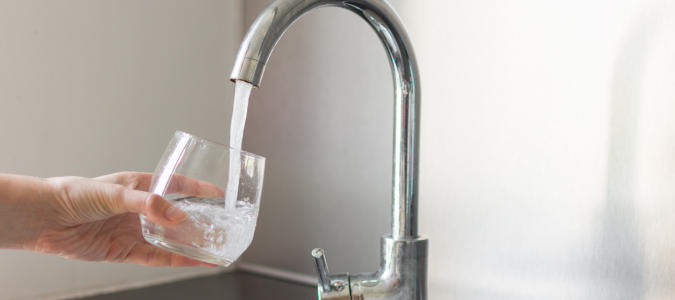Most of us don’t think much about our water. However, everyone should be more mindful of their drinking water supply at home because of synthetic chemicals called PFAS. These chemicals can find their way into the drinking water.
What are PFAS in water? Here’s a closer look into these “forever chemicals” and their harmful effects. If you want peace of mind, contact the professionals for help. Water quality experts can put measures in place to keep it PFAS-free. They can also help you understand why water quality is important.
What Are PFAS in Water? Here’s Everything You Should Know
PFAS, or per and polyfluoroalkyl substances, comprise a large group of human-made chemicals that have been in production in the U.S. since the 1940s. Manufacturers use them for household and commercial products to make them resistant to chemical reactions and heat. They also repel water, oil, grease and stains. You can find PFAS in firefighting foam, carpets, food packaging, clothing and many other items.
While PFAS are helpful in many ways, they pose various health risks to humans and animals. They’re long-lasting chemicals that break down extremely slowly, persisting in the environment for years. They can contaminate groundwater and surface water in areas where they’re produced or used. Because of how widespread and persistent they are, many PFAS are present in human and animal blood all over the globe. You can also find them in small traces in some food products.
How Can PFAS Affect Human Health?
Thousands of PFAS are found in various consumer, commercial and industrial products, making it difficult to understand their risks to human health.
According to scientific studies, these are the possible health effects of consuming PFAS-contaminated drinking water:
- Higher cholesterol levels
- Hormone disruption and higher chances of thyroid diseases
- Decreases chances of conceiving in women
- Changes in liver enzymes
- High blood pressure or pre-eclampsia in pregnancy
- Low infant birth weight
- Lower vaccine response in children
- Higher risk of testicular and kidney cancer
How to Remove PFAS From Drinking Water
Drinking contaminated water or eating food with PFAS are the most common ways to get exposed. You don’t typically absorb them through your skin. So, how do you know if your drinking water at home is PFAS-free? Unfortunately, you can’t rely on your senses because these chemicals are tasteless and odorless. Testing is the only accurate way to find out.
If you use a public water system, you can request a municipal water quality report. The law requires municipal water providers to show test results to anyone who asks. However, you’re responsible for testing water quality if you’re on a private well or spring. You can use a homeowners testing package or send a water sample to a certified laboratory.
The EPA has drinking water standards called Maximum Contaminant Levels (MCL) for six PFAS. If your test results exceed the MCLs, stop using your water for drinking, cooking, baby formula and teeth brushing. Instead, use bottled water or get your supply from a safe source. You can then get your water treated to decrease your exposure to PFAS.
Here are some treatment options you can explore with a water quality expert.
Granular Activated Carbon Filtration
This popular treatment method uses activated carbon from raw organic materials like coal or coconut shells. It traps PFAS and other contaminants as water passes through, producing clean drinking water. Granular activated carbon filtration has two forms: whole-house and point-of-use filters.
Whole-house filters treat all the water entering your home, removing chemicals before you can ingest or absorb them through your skin. Meanwhile, point-of-use filters only treat water in the locations where you’ve installed them.
Ion Exchange Treatment
Ion exchange resins are an effective alternative to granular activated carbon filtration. Remember to consider these little beads because they pack a powerful magnetic punch. Ion exchange resins come in two broad types: cationic and anionic.
The cationic exchange resins have a negative charge, removing positively charged contaminants. On the other hand, anionic resins are positively charged, eliminating negatively charged chemicals like PFAS. Anionic resins can remove various types of PFAS.
High-Pressure Membranes
Reverse osmosis and nanofiltration are two high-pressure membrane treatments you can consider for your drinking water at home. According to the EPA, they’re over 90% effective in eliminating harmful PFAS. However, there are some differences in how they work.
Nanofiltration membranes remove hardness to a high degree. However, they have a looser structure that allows sodium chloride to pass through. Meanwhile, reverse osmosis uses tighter membranes that filter out all salts.
Water filtration systems can get complicated, especially for inexperienced homeowners. If you’re overwhelmed by all the choices, let water quality specialists help. Contact a specialist to help you find the most suitable water filter system. They can also install it for you, ensure it’s working smoothly and perform regular maintenance to keep it in tip-top shape.
How Do I Know If My Drinking Water Has PFAS?
Non-stick cookware, waterproof clothing and grease-resistant food packaging make life more convenient. However, these products and many other items in our homes, offices and supermarkets can contain PFAS.
These forever chemicals can cause harm in a couple different ways. First, their chemical structure resists breakdown, allowing them to persist in the environment and our bodies. Second, they move swiftly through the environment, making it hard to prevent contamination. Unfortunately, that means these chemicals can contaminate groundwater and surface water.
So, how can you ensure your drinking water is free from PFAS? Contact your local water utility or health department and ask if they’ve tested your water for PFAS. This is crucial if you live near a contamination site. You can also use the Environmental Working Group’s national tap water database for water quality information, including PFAS data. For those with a private well or spring, it’s up to you to arrange for testing. You must find a certified laboratory and send in a water sample.
Testing your water at home can be overwhelming if you don’t know what steps to take. Skip the stress and let water quality experts take over.
Does All Tap Water Have PFAS?
If you’re concerned about your tap water containing PFAS, it’s not an irrational fear. The US Geological Survey (USGS) estimates that at least 45% of the country’s tap water contains one or more types of PFAS.
Unfortunately, the USGS only tested for the presence of 32 PFAS types. There are over 12,000 types in the environment, and not all of them are detectable by current tests. That leaves the extent of contamination in the country a mystery for now.
Why is PFAS in tap water a concern? Exposure to these chemicals can lead to various health issues, including the following:
- Various cancers, including kidney and testicular
- Liver effects
- Developmental issues in fetuses and infants, including low birth weight, immune system impairment, skeletal variations and accelerated puberty
- Immune system issues, including lower immune response and lower antibody response to vaccination
- Thyroid and cholesterol effects
Certain populations are more prone to PFAS exposure, including pregnant women, babies and children. If you’re concerned about PFAS in your tap water, you can be proactive about it by contacting water quality experts. They’ll assess the water quality in your home and put safety measures in place if there’s contamination. Reverse osmosis, ion exchange treatment and granular activated carbon filtration are all effective in lowering PFAS levels in your tap water.
Trust the Professionals for Your Water Quality Issues
Many of us are complacent about water quality. But it should be high on your priority list to keep your family safe and healthy. Contact water quality experts to test your water supply for PFAS. They can install a certified water filter system to ensure your drinking water is PFAS-free.
ABC Can Improve Your Water Quality
It can be difficult to know if you have PFAS in your home’s water. Fortunately, the professionals at ABC Home & Commercial Services can do all of the hard work for you, so all you have to do is reap the benefits! Our water quality specialists can install the best water filtration system for your needs.



